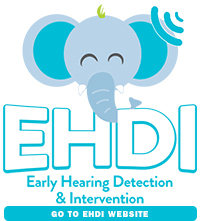Newborn Hearing Screening Program
Hearing loss is more common than any other condition screened for at birth. As many as 3 to 4 out of every 1,000 babies in the United States are born with some level of hearing loss. Based on that estimate, 33 to 44 babies are born with hearing loss in South Dakota each year.
Most babies can hear well at birth, but a few do not. Hospitals screen all babies to find the ones who may not be able to hear. Screening is the only way to know if your baby has a hearing loss. It is important to identify hearing loss as soon as possible. The first 6 months of life are the most important for speech and language development. Early identification and treatment are the keys to success. Babies who have hearing loss can be helped in many ways to develop to their full potential.
If you have questions, your baby’s doctor or audiologist are the best people to ask. If you need help finding a professional to talk to in your community, call the South Dakota Newborn Screening Program at 1-800-738-2301.
The screening is safe and will not hurt. It can be done in about 10 minutes. Most babies sleep through the screening. You will get the screening results before you leave the hospital. Be sure to tell the hospital the name of your baby’s healthcare provider or clinic so they can send them the results.
Learn About Hearing Screening Milestones Provider Form
Hearing loss is more common than any other condition screened for at birth. As many as 3 to 4 out of every 1,000 babies in the United States are born with some level of hearing loss. Based on that estimate, 33 to 44 babies are born with hearing loss in South Dakota each year.
The Department of Health Newborn Hearing Screening Program recommends that:
- All babies be screened by 1 month of age, preferably before leaving the hospital,
- If after 2 screenings the baby does not pass, a medical and hearing evaluation is needed before 3 months, and
- Once hearing loss is detected, services and intervention should be started by 6 months of age.
This 1-3-6 guideline was developed to give the baby the best possible time frame to be screened, diagnosed, and treated, if necessary. The earlier a baby is determined to have a hearing loss and begins receiving services, the more likely that speech, language, and social skills will reach their full potential.
See the link below for a roadmap of the newborn hearing screening, diagnosis, and intervention process. http://www.infanthearing.org/documents/ParentRoadmap.pdf (NCHAM)
The following videos were produced by the South Dakota Early Hearing Detection and Intervention Collaborative
Early Hearing Detection Intervention - English Early Hearing Detection Intervention - Spanish EHDI Lakota
Additional Screening
Some babies need another screening because:
- There was temporary fluid in the ear
- The baby was moving a lot
- There was noise in the screening room
- The baby has a hearing loss
Most babies who need another screening have normal hearing. It is important that you follow through with any recommendations made by the hospital staff, physician, or audiologist.
Some babies hear well enough to pass the first screening but lose their hearing later because of:
- Some illnesses
- Some injuries
- Some medicines
- A family history of hearing loss
Watch for signs of hearing loss as your baby grows — use the list in this brochure as a guide.
Signs Your Baby Can Hear
- Blinks or jumps when there is a sudden, loud sound
- Quiets or smiles when spoken to
- Makes sounds like “ohh,””ahh”
- Looks for sounds with eyes
- Starts babbling (“baba,””mama,””gaga”)
- Uses many sounds, squeals, and chuckles
- Turns head toward loud sounds
- Understands “no-no” or “bye-bye”
- Babbles (“baba,””mama,””gaga”)
- Repeats simple words and sounds you make
- Correctly uses “mama” or “dada”
- Responds to singing or music
- Points to favorite toys and objects when asked
Materials & Forms
- Newborn Hearing Screening brochure: English | en español
- Newborn Hearing Screening: What, When, and Why
- Your Baby's Hearing
- Tips for Screeners
- Audiology Services in South Dakota

